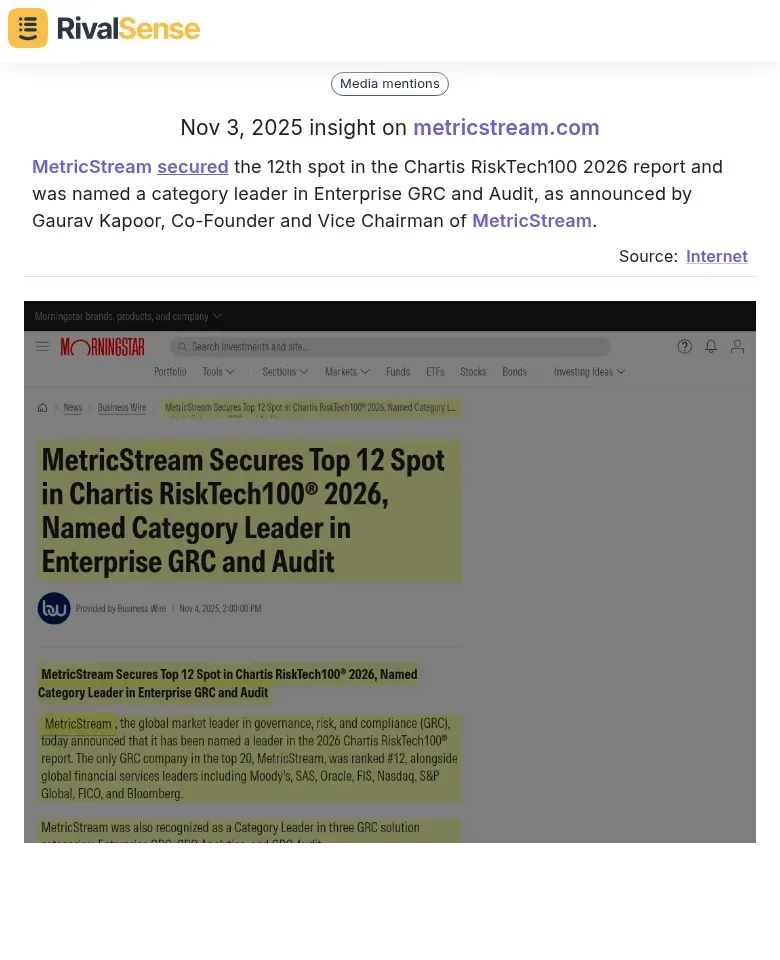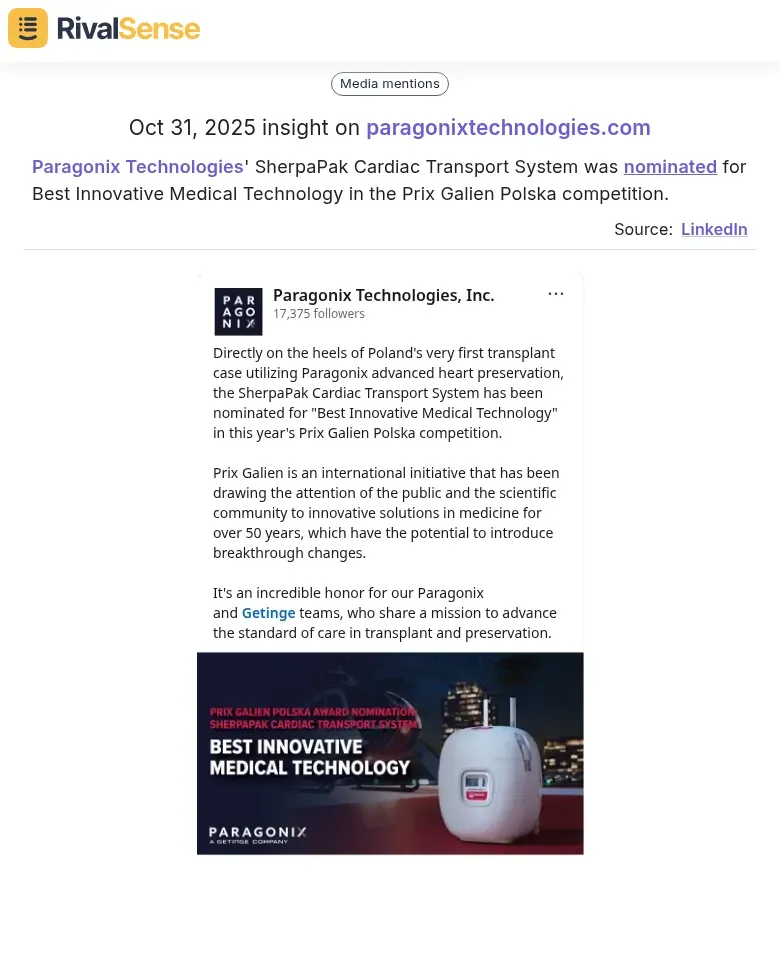How Real-Time Competitor Alerts Unlock Media and Content Insights
In today's fast-paced business landscape, real-time competitor alerts transform reactive monitoring into a proactive strategy that drives competitive advantage. This shift is critical because competitor intelligence now underpins modern decision-making—from product development to marketing spend—ensuring resources are allocated where they'll have the most impact. Media and content insights are at the heart of this advantage, allowing you to anticipate moves, identify emerging trends, and seize opportunities before they're widely recognized.
By tracking competitors' press releases, blog posts, social media buzz, and earned media mentions in real time, you uncover their strategic priorities, audience engagement tactics, and potential vulnerabilities. For instance, if a rival suddenly amplifies content on a specific topic, it might signal a new market focus you can counter or emulate.
Practical steps to get started:
- Set up alerts for competitor names, key executives, and industry keywords using tools like RivalSense.
- Monitor content frequency and themes to detect shifts in strategy.
- Analyze sentiment in media coverage to gauge public perception.
- Use insights to inform your own content calendar and PR efforts, ensuring you stay ahead rather than follow.
Industry Recognition and Award Tracking
Industry recognition and awards provide powerful signals about competitor positioning and market trends. Tracking these events helps you benchmark your company's position against industry leaders and identify what differentiators are gaining traction. When a rival wins "Best SaaS Platform" or appears on "Top 100 Companies" lists, analyze their submission materials and press releases to understand their positioning strategy.
For example, RivalSense recently tracked that MetricStream secured the 12th spot in the Chartis RiskTech100 2026 report and was named a category leader in Enterprise GRC and Audit, as announced by Gaurav Kapoor, Co-Founder and Vice Chairman.  This type of insight is valuable because it reveals competitors' strengths in specific categories, helping you align your messaging and identify gaps in your own awards strategy.
This type of insight is valuable because it reveals competitors' strengths in specific categories, helping you align your messaging and identify gaps in your own awards strategy.
Practical steps:
- Set up alerts for industry-specific award programs and rankings.
- Create a competitor award tracking spreadsheet with categories, dates, and key messaging.
- Analyze award submission criteria to understand what judges value.
- Compare your own strengths against recognized competitors.
- Use award trends to anticipate industry shifts and adjust your positioning.
Executive Leadership and Thought Leadership Monitoring
Executive leadership monitoring provides unparalleled strategic insights by tracking competitor executives' public appearances and communication patterns. When a rival's CEO speaks at industry conferences or events, they often reveal strategic priorities, upcoming market expansions, and organizational direction. This intelligence allows you to anticipate shifts and refine your competitive positioning.
A recent RivalSense insight showed that Trackunit CEO Soeren Brogaard discussed the company's growth and leadership at a Boardwave dinner in Munich on October 31.  Monitoring such engagements is crucial because executive communication patterns often precede major organizational changes, giving you early warnings about strategic pivots or alliance strategies.
Monitoring such engagements is crucial because executive communication patterns often precede major organizational changes, giving you early warnings about strategic pivots or alliance strategies.
Practical steps for effective monitoring:
- Set up alerts for "[competitor] speaking at" or "[executive name] keynote" using tools like RivalSense.
- Analyze presentation themes and messaging consistency across appearances.
- Monitor social media for live-tweeting and post-event summaries.
- Create a leadership communication log to identify patterns.
Quick checklist: ☐ Monitor executive LinkedIn profiles ☐ Track industry conference agendas ☐ Archive presentation materials ☐ Analyze Q&A sessions for strategic clues ☐ Schedule monthly leadership intelligence reviews
Product Innovation and Industry Award Nominations
Monitoring product nominations and awards provides a window into innovation trends and competitor roadmaps. Award criteria often reflect market expectations and competitive standards, helping you align your product development with industry benchmarks. If a competitor consistently wins awards in emerging tech areas, it signals a strategic focus you can anticipate or counter.
RivalSense captured that Paragonix Technologies' SherpaPak Cardiac Transport System was nominated for Best Innovative Medical Technology in the Prix Galien Polska competition.  This insight is valuable because product award nominations highlight areas of innovation and can indicate upcoming launches, enabling you to adjust your innovation strategy proactively.
This insight is valuable because product award nominations highlight areas of innovation and can indicate upcoming launches, enabling you to adjust your innovation strategy proactively.
Steps to leverage this intelligence:
- Set up alerts for competitor award submissions and nominations using tools like RivalSense.
- Identify nomination trends quarterly and map them to product categories.
- Analyze judging rubrics to understand valued qualities like user experience or sustainability.
- Use this intel to inform your product roadmap and competitive positioning.
Tip: Create a checklist of criteria from recent winners to evaluate your own products against industry standards.
Content Strategy and Media Coverage Analysis
Real-time competitor alerts transform content strategy by revealing messaging insights from competitor updates and media mentions. Tracking their content changes helps you identify trending topics and messaging shifts, allowing you to adapt your positioning and fill content gaps. Analyze press release patterns to understand strategic priorities; frequent product announcements may signal aggressive expansion, while partnership releases indicate ecosystem building.
By monitoring media coverage, you can spot content gaps—if competitors dominate certain topics but ignore others, you can fill those voids with unique perspectives. This approach ensures your content remains relevant and competitive.
Practical steps:
- Set up alerts for competitor domains and key executives.
- Track press release frequency and themes quarterly.
- Map competitor media mentions by topic to identify coverage patterns.
- Use sentiment analysis to gauge message effectiveness.
- Create a content gap analysis matrix comparing your coverage vs. competitors'.
Tips: Focus on narrative gaps competitors leave unexplored, and time your content to capitalize on competitor-driven media interest while offering fresh angles. 🎯
Implementing Real-Time Alert Systems for Maximum Impact
Implementing real-time alert systems requires strategic setup and integration to maximize their impact on your business decisions. Start by selecting monitoring tools that track competitors' website changes, social media activity, press releases, and content updates, ensuring continuous intelligence gathering. Configure alerts for key triggers like product launches, pricing changes, or major announcements to stay informed.
Integrate these insights into organizational workflows by creating dedicated Slack channels or email digests for relevant teams. Marketing can adapt campaigns based on competitor messaging, while product teams can identify feature gaps. Establish regular review meetings to discuss findings and adjust strategies accordingly, fostering a culture of proactive competition.
Measure ROI by tracking metrics such as:
- Response time to competitor moves
- Market share changes
- Content performance improvements
Practical tip: Use A/B testing to validate strategic adjustments driven by alerts and create a competitor response playbook to standardize actions across departments.
Take Action with RivalSense
To effectively implement real-time competitor alerts and gain the insights discussed, consider using RivalSense. It tracks competitor product launches, pricing updates, event participations, partnerships, regulatory aspects, management changes, and media mentions across various sources, delivering all in a weekly email report. Try RivalSense for free at https://rivalsense.co/ and get your first competitor report today to stay ahead in the competitive landscape and unlock powerful media and content insights for your business.
📚 Read more
👉 How to Monitor Competitor Leadership Changes for Strategic Insights
👉 Key Account Management Models: A Strategic Guide for Business Leaders
👉 Key Account Management Newsletters: Software Comparison and Strategic Insights
👉 How YouTube's Partner Shift Empowered Rivals' Creator Growth
👉 Avoid These Instagram Competitor Insight Mistakes for Innovation
